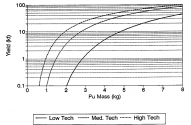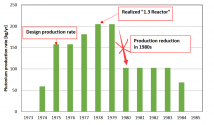Found this interesting essay when searching for more WgPu production rate assessment.
Basically the mainstream frequently quoted assumption is based on Zhang Hui's 2017 assessment, it concluded that China may have a current 2.9kg WgPu reverse.
This essay discussed Zhang's and two other assessments, arguing the plutonium rate could be higher than originally thought. Because Zhang's assumption is that China decided to half the prodution rate and shift plutonium production from purely military plutonium use to dual-use purpose in 1980. Well .... for no particular reason.
The first civilian reactor was completed and connected to the grid in 1991, almost one decade after the claimed halvation. And the shutdown of plutonium production was in 1987, five year earlier than the reactor is completed. And China also got hold of American warheads design by early 1980 and then begin true modern warhead design work. China made several attempts on build neutron bombs in 80s and two advanced primary designs and several warhead designs in 90s.
AFAIK China didn't export fuel rod to other countries and they didn't need them anyway, so the claim of halvation in my view is very suspicious without concrete proof. He was practically suggesting that China realized its huge design gap with US in 1980s and decided to go with intensive nuclear test after the chief designers wrote a joint letter directly to Deng Xiaoping for approval meanwhile ...... halving the WgPu production rate.
Here's the source he quoted for this claim, basically "I made it up" vibe.
As discussed in Jiuquan reactor case, based on the government policy on fissile material reduction in 1980s and the HEU production cases, the reactor 821 could reduce production significantly during 1980s before it shutdown. We assume the reactor had an average reduction rate around 50% during 1980-1984.
If we assume the reduction rate at 25% or 75%, it could contribute about 7 percent uncertainty to the total plutonium produced in China
The reassessment conclude that the actual WpGu stockpile is around 5,200 kg with no assumed reduction in production.
AFAIK Zhang Hui is completely wrong on plutonium usage on each primary, which he claimed that 4 kg WgPu is needed for such primary.
China has two primary stage design, respectively with 5-7kt and 8kt energy, both deduced from past nuclear test and the minimum energy needed to ignite one thermonuclear warhead.
As shown in this chart, it is absolutely no way China need 4 kg WpGu to produce a 8kt primary as almost North Korea did a better job on that. For reference the low category was what US did with Fat Man bomb, 6.1 kg WgPu for 20kt explosion.
The actual plutonium usage for each Chinese primary is likely to be around 1.5 - 1.8 kg WgPu, a.k.a 1,600 - 2000 warheads with no new production or 2900 - 3500 warheads on new reassessment.


Th



